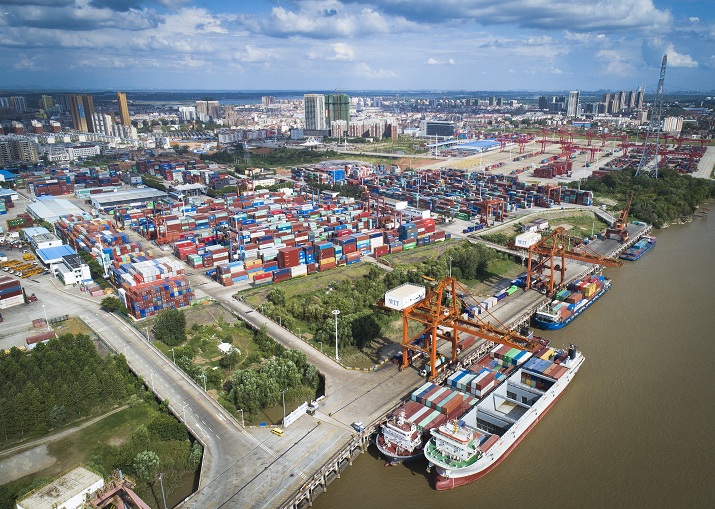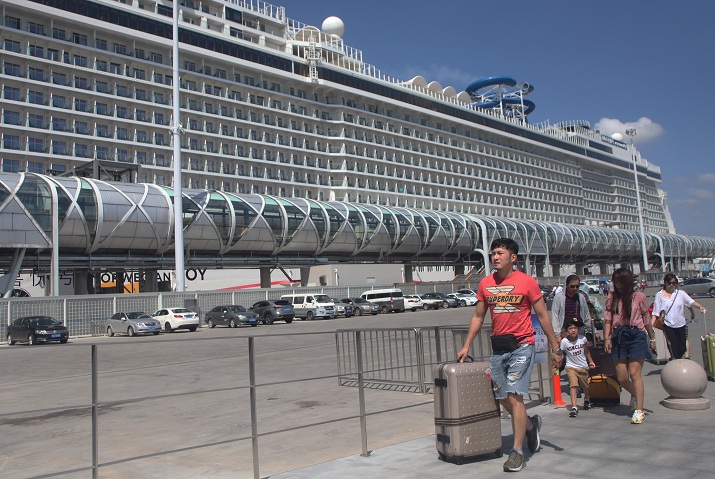|
||||||
|
||||||
| Home Nation World Business Opinion Lifestyle China Focus ChinAfrica Multimedia Columnists Documents Special Reports |
|
||||||
|
||||||
| Home Nation World Business Opinion Lifestyle China Focus ChinAfrica Multimedia Columnists Documents Special Reports |
| Nation |
| Green Waterway |
| Environmentally friendly regulation of the shipping industry boosts the prospects of the region along the Yangtze River |
| By Li Qing | NO. 40-41 OCTOBER 4, 2018 |
 Yangluo Port, an important port in the middle reaches of the Yangtze River(XINHUA)
It has been a usual sight that the luxury liner Majestic Princess operated by Carnival Group, a global cruise company, sits charging at the Wusongkou International Cruise Terminal in Shanghai.
"Through the shore power system of the terminal, 10,000 kwh of power can be supplied for the Majestic Princess," Ma Chaohui, Technical Director of the terminal's engineering management department, told Economic Daily. Shore power can help ships reduce their emissions by moving away from using oil to generate energy. "Developing a shore power system for a green port is just one of the projects for eco-friendly shipping conducted by the China Merchants Group (CMG)," Fu Gangfeng, Director and Group President of CMG Ltd., a state-owned enterprise whose traditional business is shipping along the Yangtze River, told Xinhua News Agency. The shore power supply system at the Wusongkou Terminal has been in use for a year and has already contributed to 23,000 tons in reduced emissions. The Yangtze, China's longest waterway, is one of the busiest rivers in the world. In 2017, 2.5 billion tons of goods were delivered along this west-east water route, one of the reasons why the river has become known as a golden waterway. Shipping on the Yangtze The 11 provinces and municipalities which are included in the Yangtze River Economic Belt have nearly 120,000 ships, providing more than 2 million employment opportunities in the Yangtze shipping industry. According to data from People.cn, shipping on the Yangtze produces more than 120 billion yuan ($17.9 billion) in profits annually. Compared to other methods, transportation via water has both advantages in cost and transport capacity, as well as green benefits, by saving power and reducing emissions, said Tang Guanjun, Director of the Changjiang River Administration of Navigational Affairs, in an interview with Outlook Weekly. But the shipping lanes of the Yangtze have also caused serious environmental problems. According to statistics provided by the Ministry of Ecology and Environment, 60 percent of inland vessels are distributed in the lower reaches of the Yangtze, most of which use marine fuel, a major source of pollution along the waterway. Moreover, pollution caused by industrial accidents, domestic sewage dumped by ships and heavy metal sediment from the bottom of vessels have also had a detrimental effect on the river's ecosystem. In the Three Gorges area, diesel power generation emits around 10 tons of sulfides, 4,000 tons of carbon oxides and 3 tons of PM2.5 annually, posing a serious risk to the air quality and ecological environment of the region. One of the reasons for this severe pollution is a common phenomenon in dam areas: waiting lockage, which restricts the efficiency of the Yangtze waterway. Although the Three Gorges Lock is in continuous operation, in 2017, there were 614 ships in the Three Gorges Dam area, with an average waiting time of 106 hours. During the overhaul of the ship locks in 2018, there were 1,084 ships waiting for an average duration of 202 hours. China Changjiang National Shipping Group Co. Ltd., a regional subsidiary of CMG, is China's largest inland river shipping enterprise with 827 freighters, but its cargo transportation share only accounts for 5 percent of the market. Fu noted that freighters and ships on the Yangtze run in different ways, indicating that the freight market along the Yangtze is diversifying. Accordingly, the supervision of activities and the entry standards for ships are hard to control, which increases the difficulty of maintaining orderly competition.  Tourists walk into the new terminal building at the Wusongkou International Cruise Terminal in Shanghai on July 13 (XINHUA)
Green measures "When we say there should be no large-scale development along the Yangtze, it does not mean we cannot develop the region at all, but we should stay away from destructive development, and we should follow a green development path which puts ecology first," said Chinese President Xi Jinping in Wuhan, capital of central China's Hubei Province, on April 26. Xi's proposal for the development of the Yangtze River Economic Belt also highlights the necessity of regulating shipping activities along the Yangtze waterway. In July, the Changjiang River Administration of Navigational Affairs signed a joint plan for action with the relevant departments in Sichuan, Hubei, Hunan, Jiangxi, Anhui and Jiangsu provinces and Chongqing Municipality, in order to promote the green development of the shipping industry on the Yangtze. Liu Huaihan from the Changjiang Waterway Bureau told Xinhua News Agency that during the process of improving the waterway, the concept of ecological protection is being implemented. Eco-friendly materials and structures are applied to minimize the impact on the environment in a bid to maintain a balance between regulation and protection. Building green ports is an essential and effective method of waterway regulation. In construction, high standards should be maintained when new ports are built and old ones upgraded. By regulating, integrating and upgrading existing ports, the functions of the shoreline are strengthened. Liu noted that shipping capacity has been expanded as freighters upsize and become more professional. In 2017, the average tonnage of freighters on the river reached 1,630 tons, while the average tonnage in the Three Gorges reservoir area reached 4,336 tons. Yet the level of environmental protection of these freighters needs improving. The categories of inland waterway ships should be standardized, while existing regulations can be improved. Moreover, a compulsory and well-conceived system should be established and implemented relating to the retirement of ships which fail to meet the standards, such as high-polluting and energy inefficient freighters. The use of cleaner energy in the form of liquefied natural gas (LNG) is also of great significance for the green future of the Yangtze channel. According to Fu, in terms of dry bulk cargo, 50 freighters with 8,000 to 10,000 tons of LNG fleet suitable for the Yangtze will be built in the future to replace the existing 50 percent of the ship's capacity, optimize the ship structure and reduce pollution to the environment. According to Tang, replacing heavy oil with light oil has increased annual costs by about 16 million yuan ($2.33 million). Although the costs are relatively high, all shipping companies affiliated with the CMG have had to use low-sulfur fuel since 2017. As the main force in Yangtze shipping, CMG is aiming to develop green transportation. "We must actively develop the high-end cruise business on the Yangtze, reconstruct the tourism ecology of the river, and achieve healthy and sustainable development," said Fu. Combining different resources to reduce costs, improve efficiency and protect the environment is another challenge. One potential solution is applying multimodal transport in the form of both waterway and railway. "In 2017, our cargo throughput of ports above the designated size was 2.44 billion tons, but the amount of goods that continued by rail was only 113 million tons. That is to say, the proportion of railway-waterway transport at the port was only 4.6 percent, while the proportion of developed countries is 30 to 40 percent. Our logistics cost accounts for 18 percent of GDP, which is much higher than the 8 percent of developed countries," Liu said. Advanced technology such as the mobile Internet, big data and cloud computing can play a significant role in the promotion of a new mode of waterway shipping combined with the Internet. "A smart shipping application system should be based on the construction of a digital Yangtze River and the establishment of a Yangtze shipping data center," Tang said. "Environmental recovery must be the top priority of the development so that the Yangtze River Economic Belt can develop into a golden belt with beautiful scenery and smooth traffic," Xi said. Copyedited by Laurence Coulton Comments to liqing@bjreview.com |
About Us | Contact Us | Advertise with Us | Subscribe
|
||
| Copyright Beijing Review All rights reserved 京ICP备08005356号 京公网安备110102005860号 |